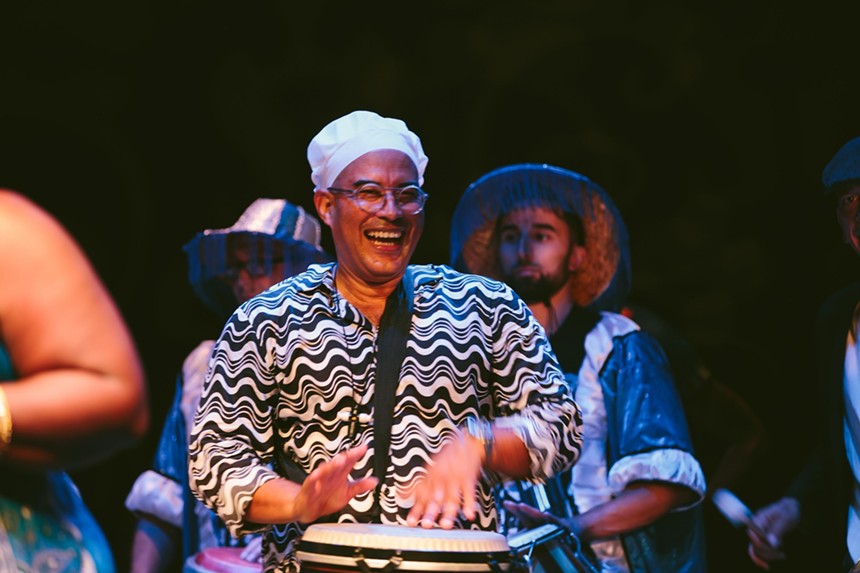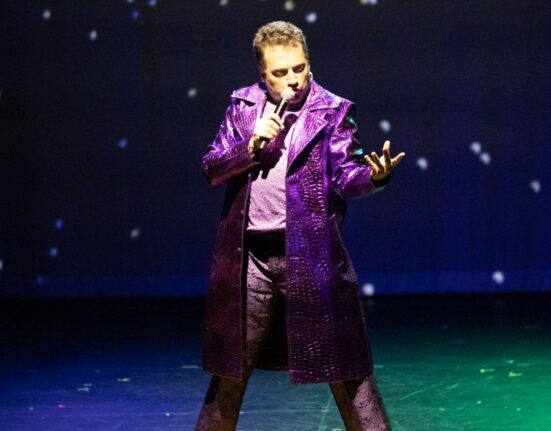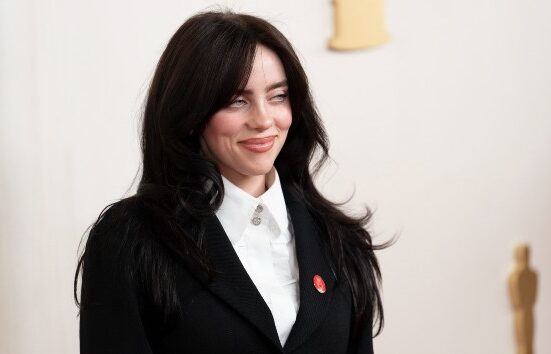The premise?
To put on a storytelling, musical, and dance performance as part of a two-year residency pairing Afro-Cuban artists with First Nation Aboriginal Australians.
“Two Islands” is the result, and now audiences can see firsthand their multidisciplinary collaboration on Saturday, December 16, at Miami Dade College’s Koubek Center.
Lang, the artistic director and choreographer for Australia’s NT Dance Company and a member of the Larrakia nation, looks forward to bringing both cultures onstage.
“The idea was absolutely brilliant because of its cross-cultural fertilization with information and the arts,” he says.
Melissa Messulam, Koubek’s general manager, initially broached the plan.
“I’ve had the privilege of living and working in Australia,” says Messulam. “I have always been moved by the energy and the magic that has been in that land. And now, I have the honor of working with Afro-Cuban artists on a regular basis. And [the performance] is really just a symbol of two cultures that I genuinely love and have a deep appreciation for.”
As part of the event, musician and educator Michael Gil will team up with Afro-Cuban dancer and choreographer Marisol Blanco, dancer Suramy Suarez, and musicians Manuel Clua, René Pedroso, and Caridad Paisán.
Yolngu elder Banula Marika and Marranunggu Marrathiyel singer-songwriter David Spry are part of the performance, too.
Gil, who has nursed a long-held interest in Australia, is thrilled that he has the chance to work with traditional people from the First Nation.
“For more than ten years, I’ve been super interested in Australia,” Gil says. “I had an incredible opportunity to meet Melissa Messulam, and she has a very strong connection with Australia. We shared our passion and our love for Australia and for the First Nations’ culture and their instruments.”
The Aboriginal didgeridoo, Yoruba bata drums, and other traditional musical instruments will be highlighted during the performance.
“Music is really important,” Gil emphasizes. “I’m from Cuba, and I was born in a family that, mostly on my father’s side, was involved in Afro-Cuban music and in a traditional way.”

Musician and educator Michael Gil participated in the international cultural exchange residency featuring Afro-Cuban artists from Miami and Aboriginal artists from Australia for “Two Islands.”
Photo by Bert Ochoa
He quickly learned how each instrument served as a conduit into the spiritual world.
“The role of the drums is to communicate with the Orisha, with the gods, and with higher spirits to call them and ask them for their blessings and powers. And so, if you don’t have those drums and play them in the right pattern, a pattern that has been kept throughout centuries of slavery and throughout the diaspora, you cannot connect with them. You cannot show up with a different type of drum. That happens with the didgeridoo, too. It’s a very primitive instrument. You cannot show up with a trombone. You cannot replace its role.”
Gil marvels at how traditional dances and songs have survived through colonization, so much so that they are still used in modern performances.
“Today, we have cell phones so we can record a class,” he says. “I cannot imagine how these people were able to transmit orally all these melodies and all these steps.”
He tells of the history, “Despite the First Nation people of Australia being invaded and colonized and the Yoruba diaspora separated from their own land and taken to the Americas, these traditions had to be reinvented, and it had to adapt to new realities. It’s incredible how, despite the harsh conditions of life, both cultures have kept the chanting, the dancing, and the patterns. And when you choose to keep something with you during times of sorrow, times of slavery, violence, or pain, it’s because it is super important.”
Learning how each other’s cultures use instruments and dance in a traditional setting has been a rewarding experience for both sides.
“I feel like a child,” says Lang with a laugh. “It’s like information overload!”
For Messulam, the more they delved into the project, the more she realized how much the two cultures had in common.
“They’re incredibly, drastically different cultures, but in talking to Afro-Cuban artists about ceremonies and rituals, I realized that these two cultures have a similarity in that they communicate their cultural content, richness, and their language through rituals and ceremony. And so, a light bulb went off, and I thought how interesting would it be to get artists from these very superficially, seemingly different cultures [to work together].”
And though bringing international artists on one stage proved to be logistically ambitious, for Messulam, it was well worth it.
“This is a very important cultural collaboration, and it was put together fairly quickly, but I am a believer that things happen for a reason and all the stars just aligned,” she says, admitting that “the challenges were from a much more bureaucratic perspective, in terms of securing funding and visas.”
She says it all came together to “work with such an incredible group of artists.”
Lang hopes that the audience will take advantage of the performance as a way to expand their horizons.
“I try to say to people don’t come with preconceived ideas; come along for the journey.”
– Sergy Odiduro, ArtburstMiami.com
“Two Islands.” 8 p.m. Saturday, December 16, at the Koubek Center, 2705 SW Third St., Miami; 305-237-7749; koubekcenter.org. Tickets cost $20.







